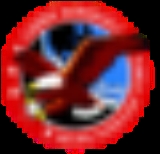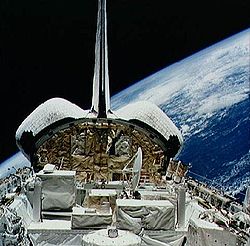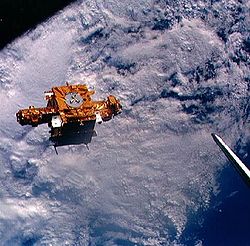
STS-56
Encyclopedia
STS-56 was a Space Shuttle
Discovery
mission to perform special experiments. The mission launched from Kennedy Space Center
, Florida, on 8 April 1993.

 The primary payload of the flight was the Atmospheric Laboratory for Applications and Science-2 (ATLAS-2), designed to collect data on the relationship between the sun's energy output and Earth's middle atmosphere and how these factors affect the ozone layer. It included six instruments mounted on a Spacelab pallet in the cargo bay, with the seventh mounted on the wall of the bay in two Get Away Special canisters. Atmospheric instruments included the Atmospheric Trace Molecule Spectroscopy (ATMOS) experiment, the Millimeter Wave Atmospheric Sounder (MAS), and the Shuttle Solar Backscatter Ultraviolet/A (SSBUV/A) spectrometer (on the cargo bay wall). Solar science instruments were the Solar Spectrum Measurement (SOLSPEC) instrument, the Solar Ultraviolet Irradiance Monitor (SUSIM), and the Active Cavity Radiometer (ACR) and Solar Constant (SOLCON) experiments.
The primary payload of the flight was the Atmospheric Laboratory for Applications and Science-2 (ATLAS-2), designed to collect data on the relationship between the sun's energy output and Earth's middle atmosphere and how these factors affect the ozone layer. It included six instruments mounted on a Spacelab pallet in the cargo bay, with the seventh mounted on the wall of the bay in two Get Away Special canisters. Atmospheric instruments included the Atmospheric Trace Molecule Spectroscopy (ATMOS) experiment, the Millimeter Wave Atmospheric Sounder (MAS), and the Shuttle Solar Backscatter Ultraviolet/A (SSBUV/A) spectrometer (on the cargo bay wall). Solar science instruments were the Solar Spectrum Measurement (SOLSPEC) instrument, the Solar Ultraviolet Irradiance Monitor (SUSIM), and the Active Cavity Radiometer (ACR) and Solar Constant (SOLCON) experiments.
ATLAS-2 is one element of NASA's Mission to Planet Earth program. All seven ATLAS-2 instruments first flew on ATLAS-I during STS-45
, and flew a third time in late 1994 on STS-66
.
On 11 April, the crew used the remote manipulator arm to deploy the Shuttle Point Autonomous Research Tool for Astronomy-201 (SPARTAN-201), a free-flying science instrument platform designed to study velocity and acceleration of the solar wind and observe the sun's corona. Collected data was stored on tape for playback after return to Earth. SPARTAN-201 was retrieved on 13 April.
The crew also made numerous radio contacts to schools around the world using the Shuttle Amateur Radio Experiment II (SAREX II), including brief radio contact with the Russian Mir space station, the first such contact between Shuttle and Mir using amateur radio equipment.
It was arguably the first time that the astronauts received amateur television
video from the ham radio club station (W5RRR) at JSC.
Other cargo bay payloads were the Solar Ultraviolet Experiment (SUVE), sponsored by Colorado Space Grant Consortium and located in a Get Away Special canister on the cargo bay wall.
The middeck payloads were the Commercial Materials Dispersion Apparatus Instrumentation Technology Associates Experiment (CMIX), the Physiological and Anatomical Rodent Experiment (PARE), Space Tissue Loss (STL-1) experiment, the Cosmic Ray Effects and Activation Monitor (CREAM) experiment. the Hand-held, Earth-oriented, Real-time, Cooperative, User-friendly, Location-targeting and Environmental System (HERCULES
), Radiation Monitoring Equipment III (RME III), and an Air Force Maui Optical Site (AMOS) calibration test.
Space Shuttle
The Space Shuttle was a manned orbital rocket and spacecraft system operated by NASA on 135 missions from 1981 to 2011. The system combined rocket launch, orbital spacecraft, and re-entry spaceplane with modular add-ons...
Discovery
Space Shuttle Discovery
Space Shuttle Discovery is one of the retired orbiters of the Space Shuttle program of NASA, the space agency of the United States, and was operational from its maiden flight, STS-41-D on August 30, 1984, until its final landing during STS-133 on March 9, 2011...
mission to perform special experiments. The mission launched from Kennedy Space Center
Kennedy Space Center
The John F. Kennedy Space Center is the NASA installation that has been the launch site for every United States human space flight since 1968. Although such flights are currently on hiatus, KSC continues to manage and operate unmanned rocket launch facilities for America's civilian space program...
, Florida, on 8 April 1993.
Crew
Mission parameters
- MassMassMass can be defined as a quantitive measure of the resistance an object has to change in its velocity.In physics, mass commonly refers to any of the following three properties of matter, which have been shown experimentally to be equivalent:...
:- Orbiter landing with payload: 93683 kilograms (206,535.7 lb)
- Payload: 7026 kilograms (15,489.7 lb)
- PerigeePerigeePerigee is the point at which an object makes its closest approach to the Earth.. Often the term is used in a broader sense to define the point in an orbit where the orbiting body is closest to the body it orbits. The opposite is the apogee, the farthest or highest point.The Greek prefix "peri"...
: 291 kilometres (180.8 mi) - Apogee: 299 kilometres (185.8 mi)
- InclinationInclinationInclination in general is the angle between a reference plane and another plane or axis of direction.-Orbits:The inclination is one of the six orbital parameters describing the shape and orientation of a celestial orbit...
: 57.0° - PeriodOrbital periodThe orbital period is the time taken for a given object to make one complete orbit about another object.When mentioned without further qualification in astronomy this refers to the sidereal period of an astronomical object, which is calculated with respect to the stars.There are several kinds of...
: 90.4 min
Mission highlights


ATLAS-2 is one element of NASA's Mission to Planet Earth program. All seven ATLAS-2 instruments first flew on ATLAS-I during STS-45
STS-45
STS-45 was a 1992 spaceflight using Space Shuttle Atlantis.-Crew:-Mission parameters:*Mass:**Orbiter landing with payload: **Payload: *Perigee: *Apogee: *Inclination: 57.0°*Period: 90.3 min...
, and flew a third time in late 1994 on STS-66
STS-66
STS-66 was a Space Shuttle program mission that was flown by the Space Shuttle Atlantis. STS-66 launched on 3 November 1994 at 11:59:43.060 am EDT from Launch Pad 39-B at NASA's Kennedy Space Center...
.
On 11 April, the crew used the remote manipulator arm to deploy the Shuttle Point Autonomous Research Tool for Astronomy-201 (SPARTAN-201), a free-flying science instrument platform designed to study velocity and acceleration of the solar wind and observe the sun's corona. Collected data was stored on tape for playback after return to Earth. SPARTAN-201 was retrieved on 13 April.
The crew also made numerous radio contacts to schools around the world using the Shuttle Amateur Radio Experiment II (SAREX II), including brief radio contact with the Russian Mir space station, the first such contact between Shuttle and Mir using amateur radio equipment.
It was arguably the first time that the astronauts received amateur television
Amateur television
Amateur television is the transmission of Broadcast quality video and audio over the wide range of frequencies of allocated for Radio amateur use. ATV is used for non-commercial experimentation, pleasure and public service events...
video from the ham radio club station (W5RRR) at JSC.
Other cargo bay payloads were the Solar Ultraviolet Experiment (SUVE), sponsored by Colorado Space Grant Consortium and located in a Get Away Special canister on the cargo bay wall.
The middeck payloads were the Commercial Materials Dispersion Apparatus Instrumentation Technology Associates Experiment (CMIX), the Physiological and Anatomical Rodent Experiment (PARE), Space Tissue Loss (STL-1) experiment, the Cosmic Ray Effects and Activation Monitor (CREAM) experiment. the Hand-held, Earth-oriented, Real-time, Cooperative, User-friendly, Location-targeting and Environmental System (HERCULES
Nikon NASA F4
The Nikon NASA F4 Electronic Still Camera was one of the first and rarest fully digital cameras ever. Constructed for NASA, it was first flown in September 1991 on board the Space Shuttle Discovery, mission STS-48...
), Radiation Monitoring Equipment III (RME III), and an Air Force Maui Optical Site (AMOS) calibration test.
See also
- Space scienceSpace scienceThe term space science may mean:* The study of issues specifically related to space travel and space exploration, including space medicine.* Science performed in outer space ....
- Space shuttleSpace ShuttleThe Space Shuttle was a manned orbital rocket and spacecraft system operated by NASA on 135 missions from 1981 to 2011. The system combined rocket launch, orbital spacecraft, and re-entry spaceplane with modular add-ons...
- List of space shuttle missions
- List of human spaceflights chronologically
- Nikon NASA F4Nikon NASA F4The Nikon NASA F4 Electronic Still Camera was one of the first and rarest fully digital cameras ever. Constructed for NASA, it was first flown in September 1991 on board the Space Shuttle Discovery, mission STS-48...

